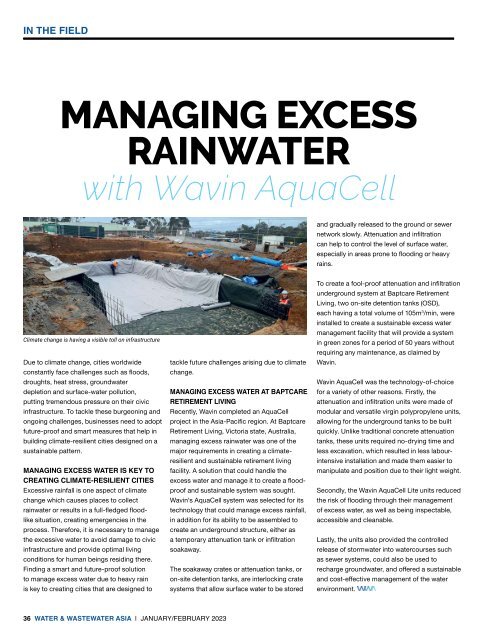Water & Wastewater Asia January/February 2023
Water & Wastewater Asia is an expert source of industry information, cementing its position as an indispensable tool for trade professionals in the water and wastewater industry. As the most reliable publication in the region, industry experts turn this premium journal for credible journalism and exclusive insight provided by fellow industry professionals. Water & Wastewater Asia incorporates the official newsletter of the Singapore Water Association (SWA).
Water & Wastewater Asia is an expert source of industry information, cementing its position as an indispensable tool for trade professionals in the water and wastewater industry. As the most reliable publication in the region, industry experts turn this premium journal for credible journalism and exclusive insight provided by fellow industry professionals. Water & Wastewater Asia incorporates the official newsletter of the Singapore Water Association (SWA).
Create successful ePaper yourself
Turn your PDF publications into a flip-book with our unique Google optimized e-Paper software.
IN THE FIELD<br />
MANAGING EXCESS<br />
RAINWATER<br />
with Wavin AquaCell<br />
and gradually released to the ground or sewer<br />
network slowly. Attenuation and infiltration<br />
can help to control the level of surface water,<br />
especially in areas prone to flooding or heavy<br />
rains.<br />
Climate change is having a visible toll on infrastructure<br />
Due to climate change, cities worldwide<br />
constantly face challenges such as floods,<br />
droughts, heat stress, groundwater<br />
depletion and surface-water pollution,<br />
putting tremendous pressure on their civic<br />
infrastructure. To tackle these burgeoning and<br />
ongoing challenges, businesses need to adopt<br />
future-proof and smart measures that help in<br />
building climate-resilient cities designed on a<br />
sustainable pattern.<br />
MANAGING EXCESS WATER IS KEY TO<br />
CREATING CLIMATE-RESILIENT CITIES<br />
Excessive rainfall is one aspect of climate<br />
change which causes places to collect<br />
rainwater or results in a full-fledged floodlike<br />
situation, creating emergencies in the<br />
process. Therefore, it is necessary to manage<br />
the excessive water to avoid damage to civic<br />
infrastructure and provide optimal living<br />
conditions for human beings residing there.<br />
Finding a smart and future-proof solution<br />
to manage excess water due to heavy rain<br />
is key to creating cities that are designed to<br />
tackle future challenges arising due to climate<br />
change.<br />
MANAGING EXCESS WATER AT BAPTCARE<br />
RETIREMENT LIVING<br />
Recently, Wavin completed an AquaCell<br />
project in the <strong>Asia</strong>-Pacific region. At Baptcare<br />
Retirement Living, Victoria state, Australia,<br />
managing excess rainwater was one of the<br />
major requirements in creating a climateresilient<br />
and sustainable retirement living<br />
facility. A solution that could handle the<br />
excess water and manage it to create a floodproof<br />
and sustainable system was sought.<br />
Wavin’s AquaCell system was selected for its<br />
technology that could manage excess rainfall,<br />
in addition for its ability to be assembled to<br />
create an underground structure, either as<br />
a temporary attenuation tank or infiltration<br />
soakaway.<br />
The soakaway crates or attenuation tanks, or<br />
on-site detention tanks, are interlocking crate<br />
systems that allow surface water to be stored<br />
To create a fool-proof attenuation and infiltration<br />
underground system at Baptcare Retirement<br />
Living, two on-site detention tanks (OSD),<br />
each having a total volume of 105m 3 /min, were<br />
installed to create a sustainable excess water<br />
management facility that will provide a system<br />
in green zones for a period of 50 years without<br />
requiring any maintenance, as claimed by<br />
Wavin.<br />
Wavin AquaCell was the technology-of-choice<br />
for a variety of other reasons. Firstly, the<br />
attenuation and infiltration units were made of<br />
modular and versatile virgin polypropylene units,<br />
allowing for the underground tanks to be built<br />
quickly. Unlike traditional concrete attenuation<br />
tanks, these units required no-drying time and<br />
less excavation, which resulted in less labourintensive<br />
installation and made them easier to<br />
manipulate and position due to their light weight.<br />
Secondly, the Wavin AquaCell Lite units reduced<br />
the risk of flooding through their management<br />
of excess water, as well as being inspectable,<br />
accessible and cleanable.<br />
Lastly, the units also provided the controlled<br />
release of stormwater into watercourses such<br />
as sewer systems, could also be used to<br />
recharge groundwater, and offered a sustainable<br />
and cost-effective management of the water<br />
environment.<br />
36 WATER & WASTEWATER ASIA | JANUARY/FEBRUARY <strong>2023</strong>


















